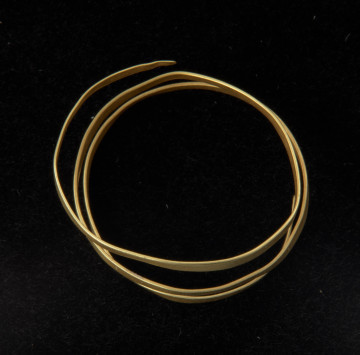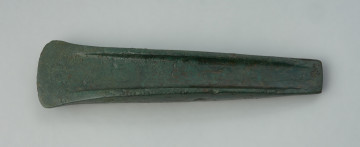
A wire-coil temple ring
around 1700 p.n.e. — 1600 p.n.e.
National Museum in Szczecin
Part of the collection: Bronze Age
This magnificent ornament was made from a thick brown rod. Both ends of the object are bent into the shape of a tiny foot; groups of transverse lines and the motif of the so-called wolf teeth decorate the surface. The bracelet, alongside a twin specimen and a thin, undecorated rim and a bronze axe, was part of the hoard. This find was donated to the collection of the Society of History and Antiquities of Pomerania (Towarzystwo Historii i Starożytności Pomorza) in Szczecin in 1904 by Paul Rübsam, a reserve captain, the then owner of the Domacyno estate. From the donor's laconic information, we know only that the hoard was in peat. For many years it was stored in the Szczecin's Museum. In August 1944, together with other valuable exhibits, it was transported deep into Germany and hidden there from wartime destruction or looting. The hoard, which was considered lost, survived the war. It was transferred to the resources of the National Museum (Muzeum Narodowe) in Szczecin in 2009 due to the bilateral Polish-German exchange of ancient archaeological artefacts. It was shown at an occasional exhibition organised at that time. Massive hoops with foot ends are rare, making them interesting from a museum and scientific point of view. So far, bracelets of this type, dating to the 1st half of the 2nd Bronze Age (approx. 1600-1500 BC), have been found in only five hoards discovered at the turn of the 19th and 20th centuries. As many as four of them come from Pomerania, hence the assumption that this region may be their cradle. Besides the specimens from Domacyno, there also remain ones from the hoard from Rościęcin, stored in one of the museums in Berlin, and hoops from Grodnica, being in the collection of the Archaeological Museum (Muzeum Archeologiczne) in Poznań.
Dorota Kozłowska
Author / creator
Dimensions
the entire object: height: 6 cm
Object type
bracelet, bangle (hoop), body adornment
Technique
carving, casting
Material
bronze
Origin / acquisition method
legal transfer
Creation time / dating
Creation / finding place
Owner
National Museum in Szczecin
Identification number
Location / status

around 1700 p.n.e. — 1600 p.n.e.
National Museum in Szczecin

around 1700 p.n.e. — 1500 p.n.e.
National Museum in Szczecin

around 1500 p.n.e. — 1300 p.n.e.
National Museum in Szczecin
DISCOVER this TOPIC
Castle Museum in Łańcut
DISCOVER this PATH
Educational path